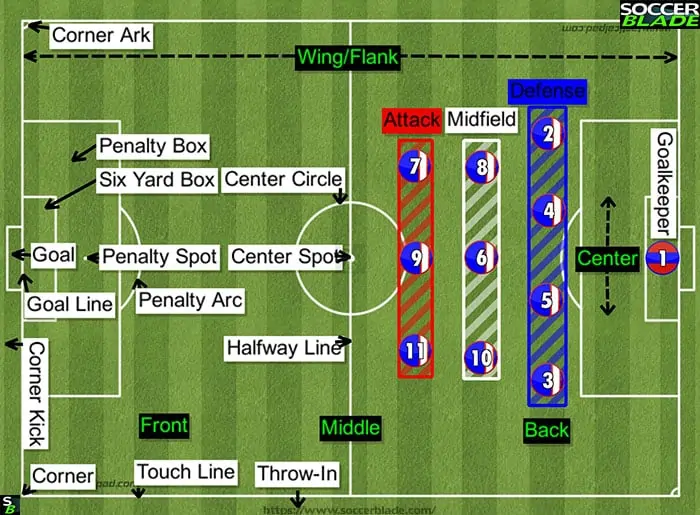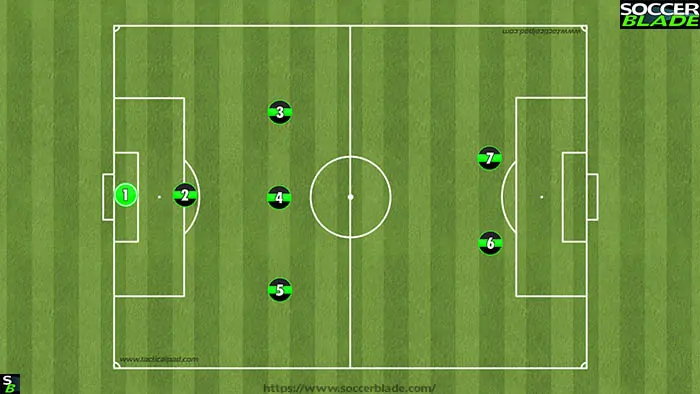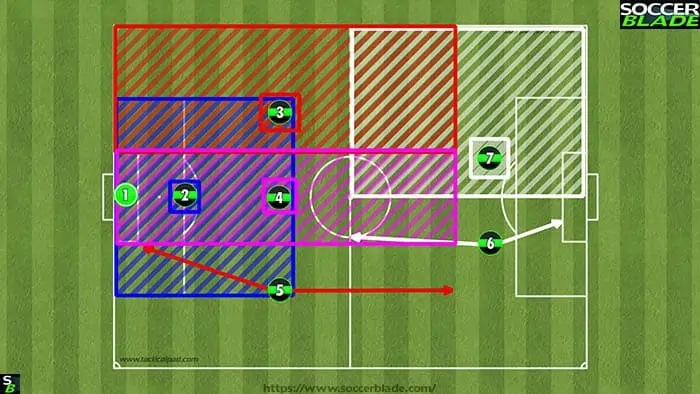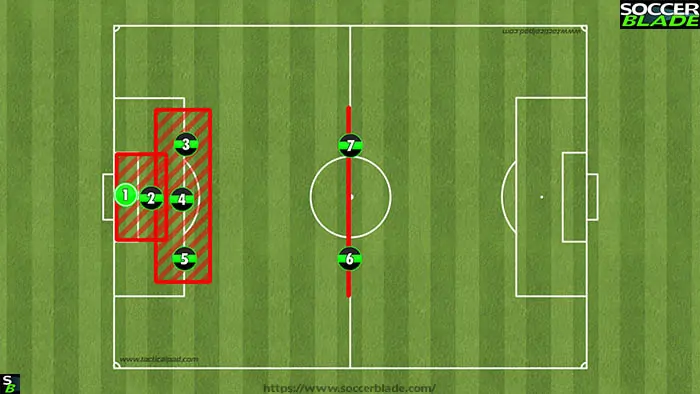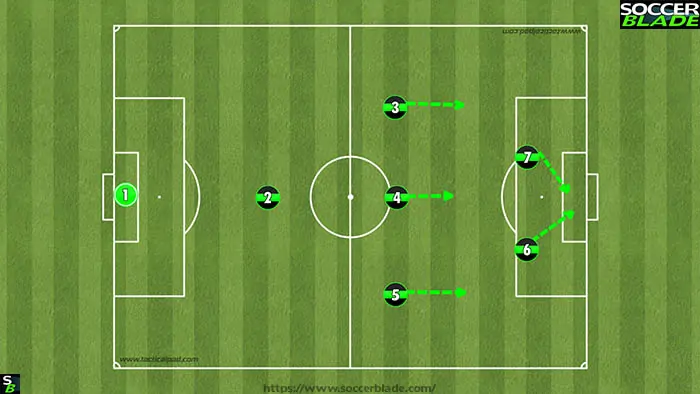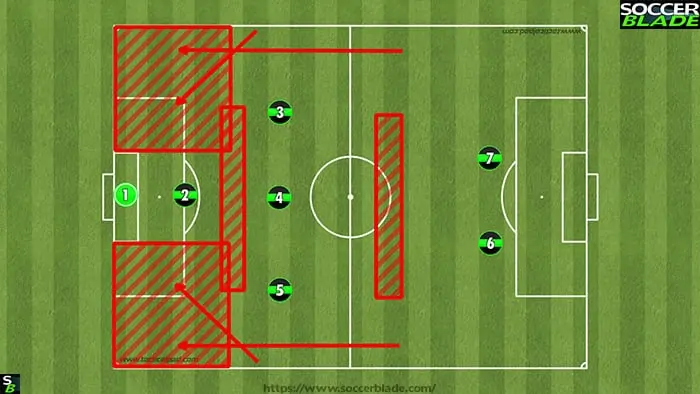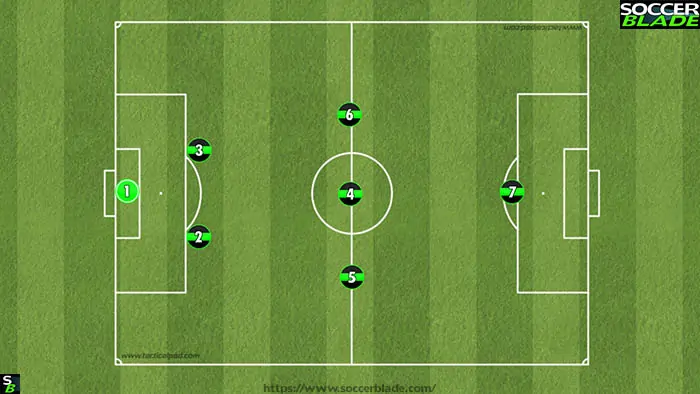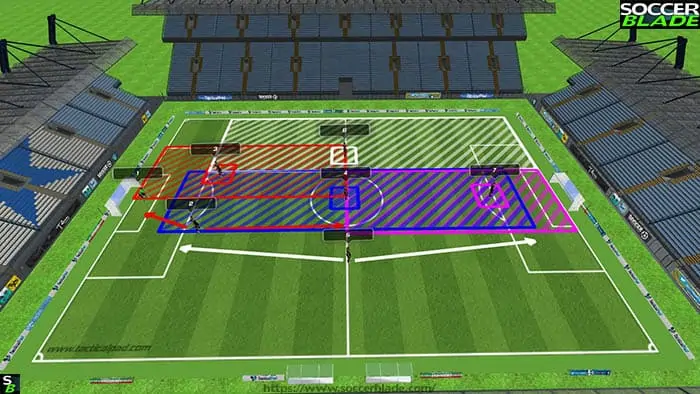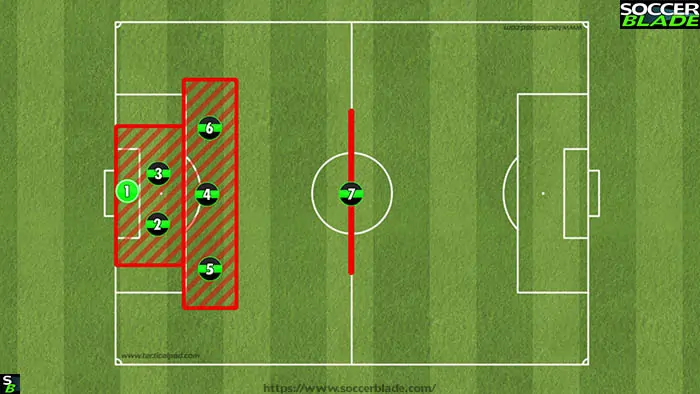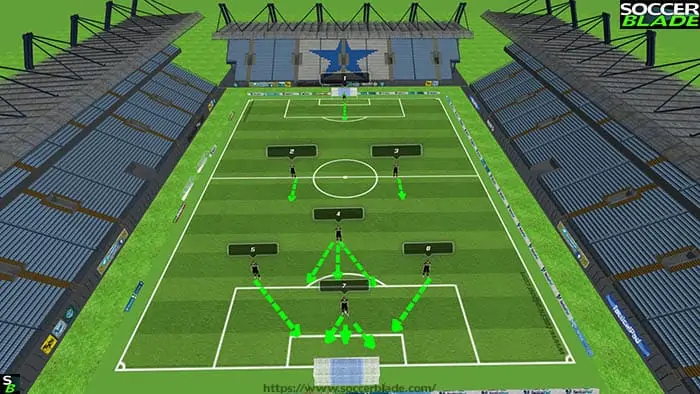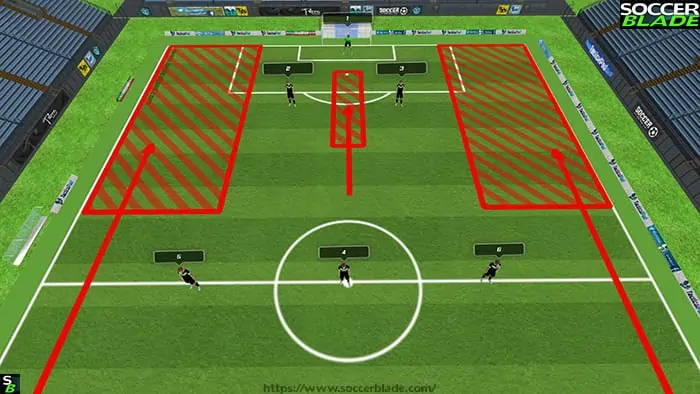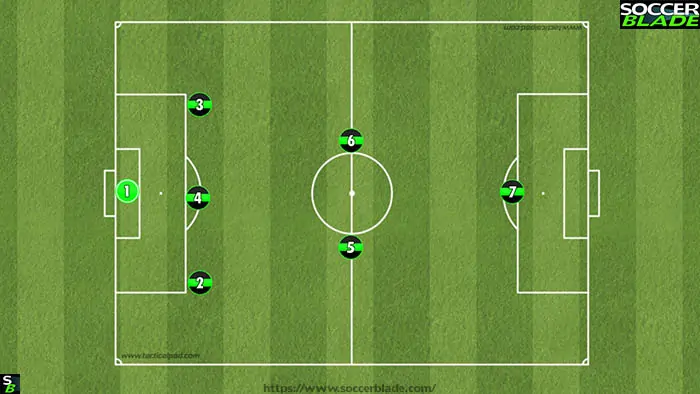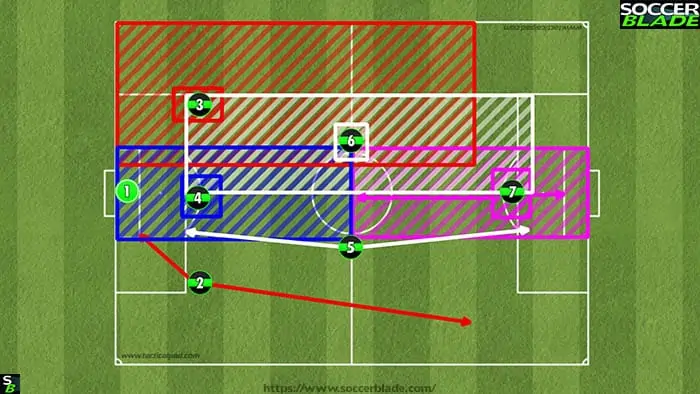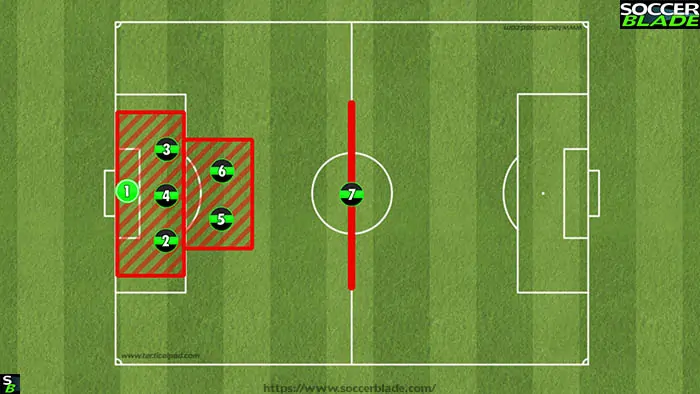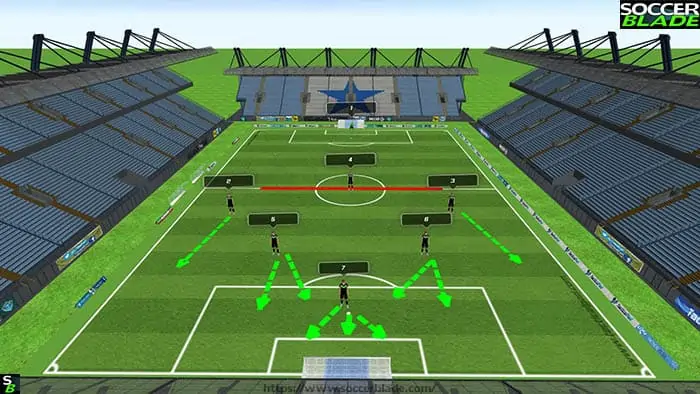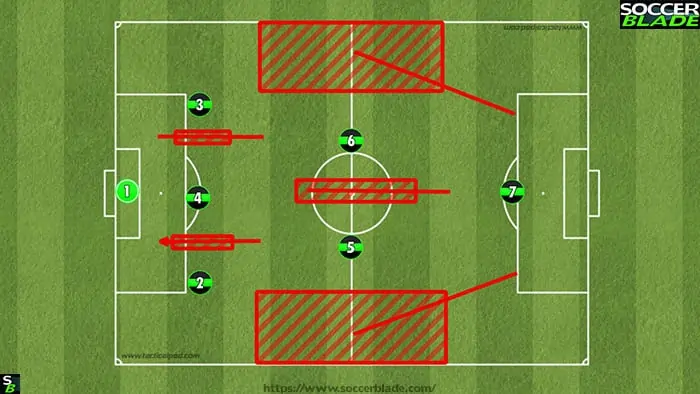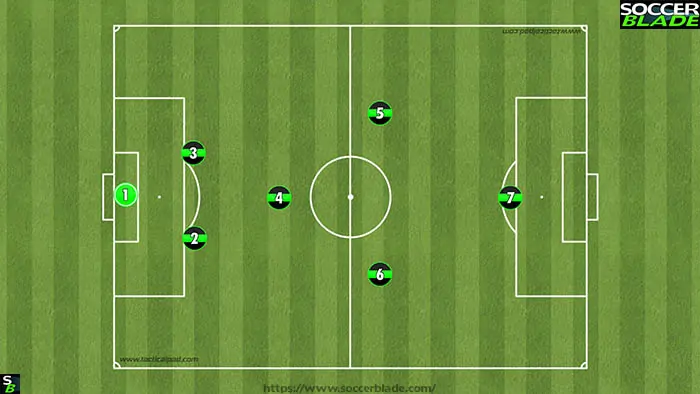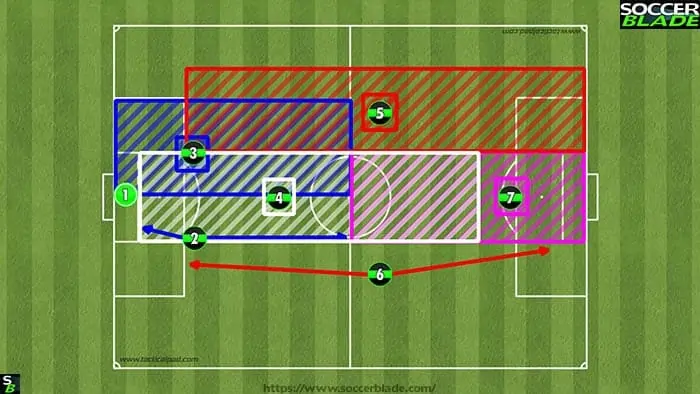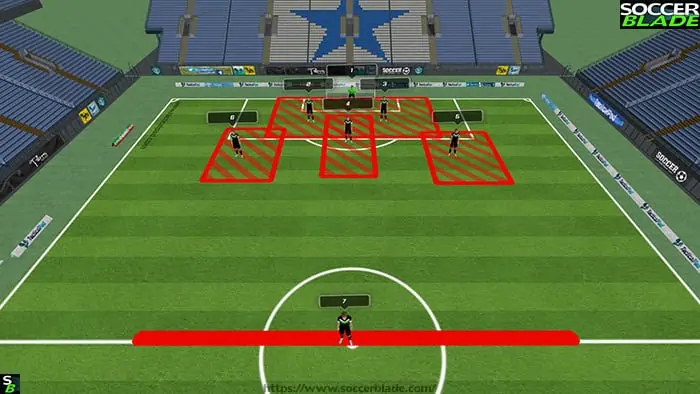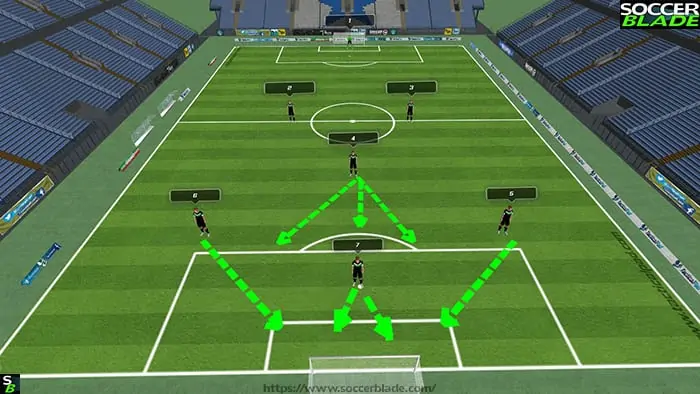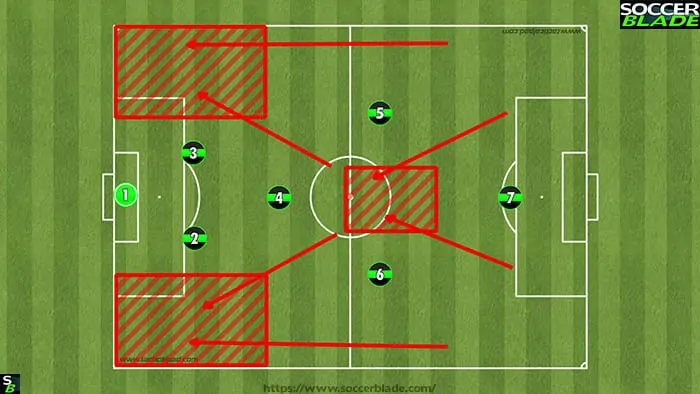Share the post "5 Best 7v7 Soccer Formations (u12 Positions & Diagrams)"
Formations can win or lose games. For youth teams, it is best to begin with a simple defensive formation that the players understand, as they’re still learning the game.
Once the players have a good relationship, you can experiment to decide what is best. This article will give you all the information you need to beat the best 7v7 teams for your u12 team.
The best formations for 7v7 are;
- 1-3-2
- 2-3-1
- 3-2-1
- 2-1-2-1
We will look at how you can play each of these formations in detail.
What are the best 7v7 soccer formations?
For a defensive system, pick a 3-2-1. For a standard formation, choose 2-3-1; for an attacking formation, go for a 1-3-2.
Picking a formation depends on what type of players you’ve. This will make your choice easier if you’ve got a great striker or defender. Play to your team’s strengths to get the most out of your players.
Before we look at formations, for those that are newer to the game, here is a soccer field diagram to show what is what.
How to Coach 7v7 Soccer (Positions – Players – Tactics)
Choosing your formation to play will depend on the following key points. When picking your system, getting the best out of your players is the intention.
Where to Put The Best Players
Players often have a favorite player to play with – a trust factor may be because of a knowledge of what they can do and where they will be.
A common saying in soccer is to build a team around your best player. Wherever that player is playing, who do they work with the best?
If your best player is a midfielder who can play a ball 60 yards into the corner, have a winger willing to run into space.
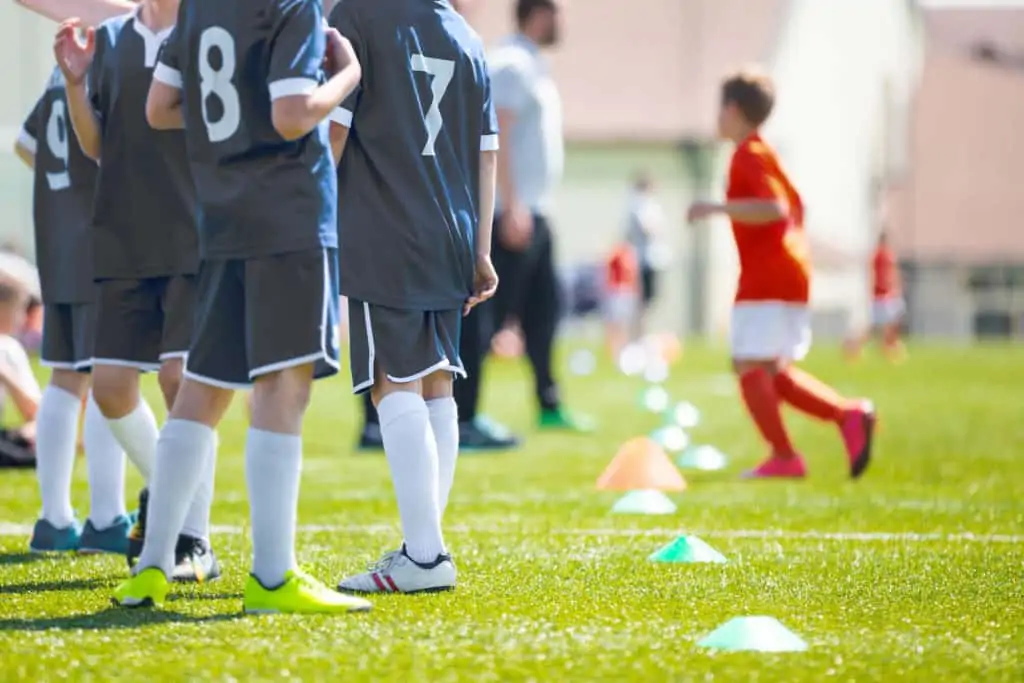
Where to put Weak Players
An opponent will look for weaknesses in your team, and any good coach will change the game to utilize your weak point. Be sure to minimize the risk by pairing players up who combine well.
You might have a central defender who’s good at heading the ball but is slow. Players who play next to each other ideally complement one another with their attributes.
How to Use Pace & The Fastest Players
Having pace is always a good trait for a team. It can be influential whether the full-back is in recovery or a winger taking on a player.
You don’t necessarily need the speed if you’ve players like Iniesta and Xavi, who can accurately control the ball and pass.
A player with pace is best placed in a position that’ll be dangerous. Have them in a position where they will more often face a 1-on-1 situation.
Player Combinations – Defense & Attack
Tiki Taka is widely known for its combination play. That’s short, quick passing with one or two touches, played at a speed that is hard to close down and intercept.
When players are in their positions, they will not only be combining with those directly next to them but those on a diagonal. So a full-back will be linking with a central midfielder.
Forming combinations can be highly effective, you ideally need to play in triangles.
A player ideally will have two options when to pass the ball – this is the triangle. Players waiting for a pass will constantly move to create an opportunity to pass.
When the ball is passed, there will be a new triangle of players that should be on the move away from their markers.
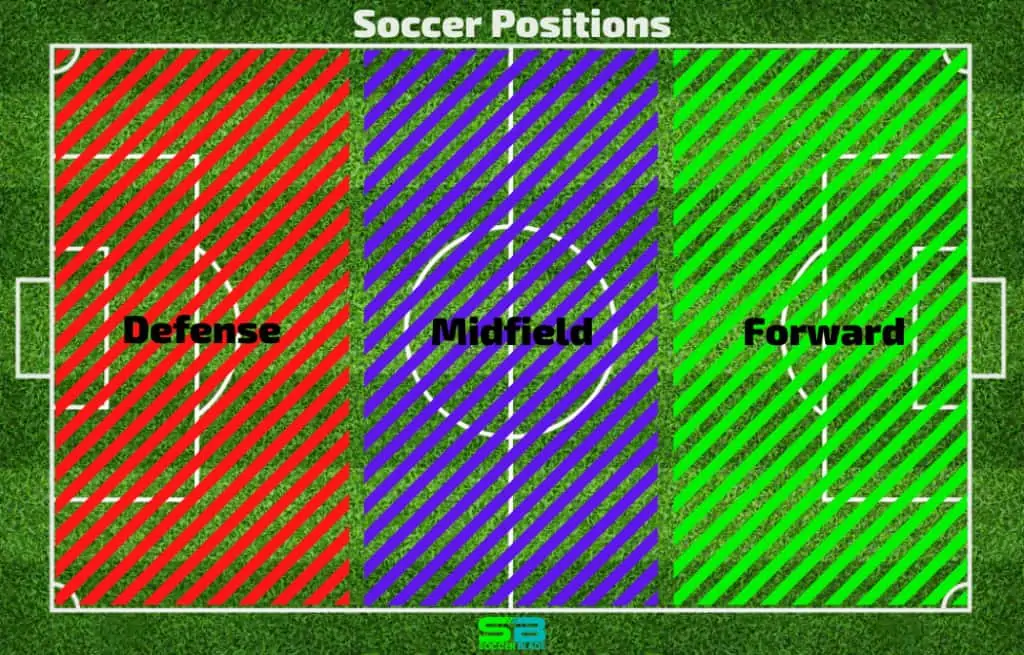
Isolated Players – Work as a Team
In a 5-3-2 formation, the full-backs are expected to work the full field length. They can become isolated. When picking players to play there, it is important to have the right attributes.
They need a good ‘engine’ to get up and down. The same applies to lone strikers; they need support from other players or a quality pass.
The striker will often be playing against two defenders, so they either need to have the pace to get behind or be able to hold up the ball.
1-3-2 7v7 Soccer Formation (Sweeper-Attack)
Pros
- Security of a sweeper
- 2 strikers
- 3 defense/midfield
Cons
- It needs a good sweeper
- Narrow
- Striker combination
If you’ve got a good defender you can trust to keep the opposition from scoring, this could be a formation for your team.
With three players in front of the defender, they give help when needed and advance in possession. Having two strikers can cause any team problem, as long as they can find space and they can be found.
The strikers must work together and combine their play with being effective.
1-3-2 Player Zones
The sweeper must defend against any danger, so they’re positioned in and around the box to stop what they can.
The central midfielder will help defend and create attacks by supplying the striker. The two wide midfielders cover a larger area than the central one as there is less play on the wing.
This central three system is easy to coach to the players, as they’re in line with one another and cover the same length of the field.
The two strikers will occupy the opponent’s half, covering all areas when they need to make runs or find space.
With four players behind the strikers, if you’ve got a solid base, you can allow the strikers to cause problems. The strikers should be good at combining with one-twos.
1-3-2 Defensive Positions
The sweeper in defense will be in front of the goalkeeper, protecting the danger zone around the goalmouth.
The three players in front will need to drop back into the box to cover areas and follow runs. The two strikers will stop the ball from being played back to the opposition defense, so they limit their options.
Then when possession is regained, they will be moving into space, looking for a ball played through to them.
1-3-2 Attacking Positions
The sweeper will stay in his/her half and be the last player back with no one between themselves and the keeper.
They will sometimes be required to play the ball back to their midfielders or strikers if they have a good kick.
The midfield is a place where you can have a couple of varieties. It is never the best idea for all of them to attack, so you’ll have the central one attacking or the two wider midfielders attacking.
If the players combine the two, it’ll put the opposition on the back foot. The strikers will make runs in and around the box, always looking for space, so they’re free for a strike.
1-3-2 Danger Zones
The wide positions are where the opposition can cause problems. This is when the team needs to work as a unit to keep compact.
If the ball is wide, the team needs to shift together. The midfield’s main responsibility is to defend. This is because you’ve two strikers so that they will cover the dangerous areas.
The space behind the strikers can be covered if one or two retreat back if problems are being caused.
2-3-1 7v7 Soccer Formation (Diamond-Strong)
Pros
- Common formation
- Two defenders
Cons
- Lone striker
- narrow
The 2-3-1 diamond is a common formation for the under 10s, and the players will be comfortable with it.
The main question to address is, do you have a good striker? The striker must be a good runner and someone who takes chances to score goals.
With two defenders at the back, it is secure enough to focus on creating attacks with the other players without being too risky.
2-3-1 Player Zones
The two defenders will defend their side in front of their goal. The midfielders will cover a large distance to supply and support the striker.
The striker, when attacking, should keep around the danger zone in the center, so if an opportunity comes, they take it.
2-3-1 Defensive Positions
Having two defenders in front of the goalkeeper gives security to the team. The midfield will protect the defenders, stop long-range shots, and move across to where the danger is.
The striker is to patrol the halfway line, ready to intercept the play to break.
2-3-1 Attacking Positions
When the ball is near the opposition’s goal, your keeper will come out to the edge of the box in case a ball is played through where they can intercept.
The defenders are to recycle the ball back to the attackers if needed.
The shape of this attack comes from different directions, the four need to combine plays and make runs to be effective.
2-3-1 Danger Zones
The corners are most exposed, so if there is just one attacking player, one of the defenders can deal with it.
If the defenders are occupied, or the opposition is camped in your half, the midfielder will go wide, and the other two midfielders will move across to occupy the other places.
A problem can occur if the defenders are spread apart, this will cause a gap in the middle, allowing attacks and runs centrally.
Be sure to keep a close distance between the two.
3-2-1 7v7 Soccer Formation (Strong-Base)
Pros
- Defensive
- Adaptable on break
Cons
- 1 striker
- Narrow attack
If you’re a new team to coach or want to make your team concede fewer goals, this 3-2-1 formation may be the solution. Having a solid foundation and developing a team from there is always best.
Once the players understand the game, you can adapt the formation. This requires a good striker that can work on their own.
3-2-1 Player Zones
The fullbacks can move forward when in possession or dribbling, but they can’t leave the center back exposed. The center-back will concentrate on defending, they will be the last player between the goalkeeper.
The midfielders need to support the striker will through balls and runs. They must take risks knowing that they have three defenders behind them.
3-2-1 Defensive Positions
With all the players back in position, the goal is well protected. Three defenders in the box are hard for an opponent to break down, with the two midfielders blocking.
For the under 10s, it is the best formation for defending, but with so many players back, there must be a way to attack.
When the midfielders regain the ball, they should run into space, this is normally on the wing.
3-2-1 Attacking Positions
From a very defensive shape to an adventurous one. This formation aims to get the players into these positions, which can be tough when defensive.
If the center-back is not marking a player or they’re comfortable marking one player, the other two defenders can push up.
The striker and midfielders have the responsibility to score goals. They will be attack-minded and make runs towards the goal.
3-2-1 Danger Zones
The problem areas for this formation are out on the wings in midfield. This is not a bad place to have problem areas, it’s far from the goal.
To keep the shape, the wide defenders should deal with the problem when it gets to them so the team is not spread out.
Keeping compact in any formation is the best way to defend, so instead of players being drawn to the ball, it is best to hold position and retreat if the ball is moved into your half.
This way, the goal, and the midfield will be protected.
2-1-2-1 7v7 Soccer Formation (Dynamic-Flow)
Pros
- Defensive midfielder
- 3 attacking player
Cons
- Attacks on the wing
- 1 striker
If you’ve got a good striker and two good players at running with the ball, this 2-1-2-1 formation is ideal.
You will mainly have three defenders and three attackers, and the defense is having problems the two wide forward players can drop back.
2-1-2-1 Player Zones
The two center backs are to defend up to the halfway line and not let anyone past them. The center midfielder’s main role is to protect the defense and support when attacking.
The wingers will attack and support the striker as much as possible so the striker is not isolated. The striker will hold up the ball and be around the goal area for any chances.
2-1-2-1 Defensive Positions
With all the players back, the team has a good shape. This is only possible when the two wide players get back, so they must be able to run good distances.
The position of the midfielders blocks the gaps that the defenders cannot occupy. The striker will stop the opposition’s defenders from playing the ball.
2-1-2-1 Attacking Positions
The striker will be central to the goal and make runs into space with the wingers coming in from the sides.
The midfielder will begin attacks, feeding the wingers and striker.
2-1-2-1 Danger Zones
The danger zone in front of the midfielder is safe enough unless the opposition has a good player at passing and causing danger.
The corners are the other issue; as a team, you can keep your positions and defend the center of the goal, or a player can move across to tackle or restrict them.
7v7 Soccer Formations PDF
Free PDF Download: Under 10’s 7v7 Soccer Formations – Infographic – Tactics Field
Related Questions
Which soccer player’s position runs the least?
A goalkeeper will run the least each game, and for the outfield players, it’s normally the center back.
Do midfielders score goals?
The midfielder will score but not as often as the striker. You should expect the midfielders to score 25% of the number of goals a striker would score.
Do soccer numbers mean anything?
Goalkeepers are normally numbers 1 or 13, the defenders 2 to 5, midfielders 6, 7, 8, 11, and the strikers are 9 and 10. This will vary for each formation and professionals with squad numbers of 13 +.
Share the post "5 Best 7v7 Soccer Formations (u12 Positions & Diagrams)"
Joel is a seasoned soccer journalist and analyst with many years of experience in the field. Joel specializes in game analysis, player profiles, transfer news, and has a keen eye for the tactical nuances of the game. He played at various levels in the game and coached teams - he is happy to share his insight with you.

